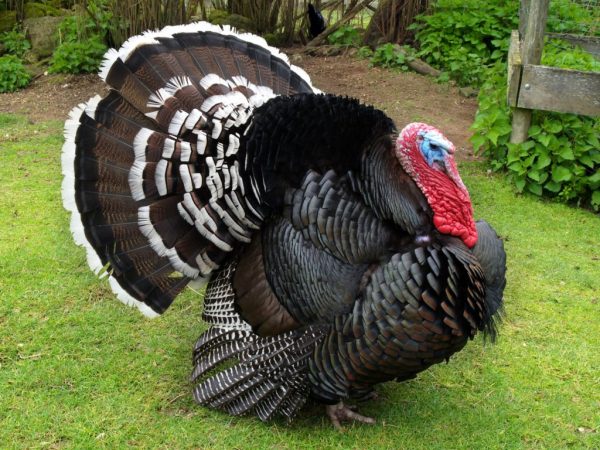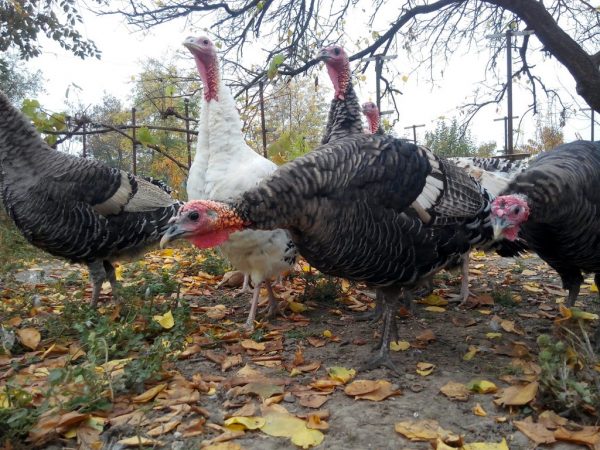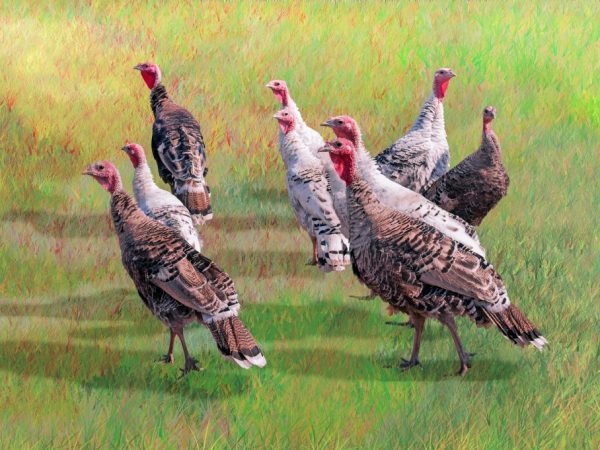The most common turkey breeds
It is much more profitable to breed turkeys at home than all the rest of your bird. This is due, first of all, to the fact that a turkey can gain up to 10-12 kg of weight. And if we talk about broiler turkeys, then they gain up to 20-23 kg. In addition, turkeys lay large eggs that are suitable for human consumption. The weight of one egg reaches almost 100g. Consider which turkey breeds are the most popular today.
- Grade maker
- Conditions of detention
- North Caucasian bronze turkey
- Meat and egg productivity
- Conditions of detention
- White broad-chested turkeys
- Meat and egg productivity
- Features of the content
- Bronze broad-breasted turkeys
- Meat and egg productivity
- Features of the content
- Black Tikhoretskaya breed
- Meat productivity and egg production
- Features of the content
- Canadian turkeys
- Meat productivity and egg production
- Features of the content
- Moscow bronze turkeys
- Meat productivity and egg production
- Features of the content
- Features of choice
- Conclusion

The most common turkey breeds
Immediately, we will make a reservation that meat breeds of turkeys are more popular, therefore we will not consider breeds with low meat productivity.
Grade maker
Breeders worked on the breeding of the grade maker breed. They were faced with the task of obtaining a turkey with high meat productivity, and improving taste of meat... It took a lot of time to breed the breed, but the specialists coped with the task. This breed is very popular in Europe. In Russia, however, it is not yet very common.
The meat productivity of males is, on average, 19 kg. Females gain 10 kg less. The meat has a delicate taste and is dietary, since the fat content in it is minimal. the breed is distinguished by its early maturity. It is worth noting that Great Maker turkeys are resistant to various diseases and adapt well to any conditions. Therefore, in Russia and Belarus, where the climatic conditions are quite harsh, it is profitable to breed this breed of turkeys.
Egg production is, on average, 95 eggs. Egg weight varies from 80 to 85 g.
Conditions of detention
When keeping turkeys of this breed, it is necessary to ensure a temperature of 18-220C in the poultry house. You also need to make sure the house is dry. Dampness is the main enemy of all turkey breeds. Grade maker turkeys are aggressive. To avoid fights in the poultry house, there should be 7-8 times less males than females.
When setting up a poultry house, consider the considerable weight of adults. We make perches and nests from durable wood. We set up perches at a distance of 50 cm from the floor. So that the birds are not crowded, we allocate at least 60 cm of perch for one turkey.
There should be plenty of sunlight in the house. Therefore, take care of the presence of windows. In the absence of sunlight, birds slowly gain weight. Also, the lack of sunlight negatively affects the formation of immunity. An artificial light source cannot replace the sun's rays.
Birds need to systematically clean their plumage.for this they use sand and ash. Therefore, we put a container with ash and sand in the poultry house or aviary. In the absence of feather cleaning, there is a high probability that parasites will start in the plumage. And turkey feathers on the market are prized for their lightness and softness.
North Caucasian bronze turkey
The North Caucasian bronze turkey was bred a long time ago by breeders of the Stavropol Territory. The progenitors of the North Caucasian turkeys are bronze broad-breasted. Due to this broiler breed improved the performance of local birds, with which she was crossed. The Caucasian turkey got its name due to the fact that it is most common in the Caucasus. At one time, this breed of turkeys was brought to Bulgaria and Germany, where it is in demand today.
North Caucasian bronze turkeys have an unusual color. The main color of the pen is black. A bronze tint appears in the sun. Also in sunlight, feathers play with green and golden colors. On the back there is a wide stripe of bronze shade, which is a decoration of birds. There is a similar stripe on the large and lush tail. The chest is decorated with a thin white border.
Meat and egg productivity

The breed has good egg production
Among all meat breeds of turkeys, the North Caucasian one is not the largest. The weight of an adult male is, on average, 13 kg. The female weighs, as a rule, no more than 7 kg. But poults gain weight very quickly. With proper nutrition, already at the age of 4 weeks, their weight is 4 kg.
Egg production is 80 eggs. It should be noted that almost all eggs are fertilized and can be used for hatching chicks. According to research, the hatchability of eggs is at least 80%. At the same time, a very viable young growth is born. No more than 10% of chicks die.
Conditions of detention
conditions of detention all breeds of turkeys are approximately the same. Since we have considered them in sufficient detail above, we will dwell only on the specific features concerning the North Caucasian breed of turkeys. These birds are mobile. Therefore, they need a large aviary.
The North Caucasian breed of turkeys does not tolerate cold well. But it adapts to the hot climate quickly enough. Therefore, this breed is not suitable for keeping in those regions where summer starts late and autumn early.
A feature of the North Caucasian turkey breed is that it can be used to improve any local breed.
White broad-chested turkeys
Considering the breeds of turkeys for breeding at home, one cannot fail to mention the white broad-breasted. They are originally from the USA, but they have taken root well in our country. During the breeding work, a bronze broad-breasted turkey was used. But the turkey inherited the color of the plumage from the white Dutch, which was also used for breeding the breed.
Meat and egg productivity
White turkeys, according to such a criterion as Meat productivity, are divided into 3 groups.
- The first group includes individuals whose weight is 9 and 6 kg for males and females, respectively. This is the so-called light cross. Despite the low rate of meat productivity, light crosses have their own advantages, the main of which is the ease of maintenance. These turkeys do not have to add large portions during feeding.
- Medium cross males gain 16 kg, Females - 7 kg.
- Heavy Cross is in particular demand among people who are engaged in turkey breeding as a business. The weight of males sometimes reaches 26 kg. Females gain 9-10 kg.
Females of the white broad-breasted turkey are valued for their meat production. They lay from 120 to 150 eggs per year. Egg weight is, on average, 85 g. At least 85% are fertilized. And hatchability is 77.5%. And this is a high percentage.
Features of the content
If we consider different breeds of turkeys, then we can say that the white broad-breasted is one of the most susceptible to climatic conditions, which complicates its maintenance. In the poultry house you constantly need to maintain a certain temperature regime, monitor the humidity and the duration of daylight hours, and ensure that there are no drafts.
But, all investments will pay off in 5-6 months. By this age, white turkey poults are gaining maximum weight. But in order to get the desired gains, you need to provide good nutrition. This breed of turkey is fed a good quality compound feed at least twice a day. In addition to compound feed, white turkeys need a lot of green feed. Therefore, they will have to be released into the pasture.
Bronze broad-breasted turkeys

A feature of the breed is plumage.
Sometimes this breed of turkeys is called French. The bird received this name due to the fact that it enjoys the greatest popularity in France. But her homeland is the United States. A bronze broad-breasted turkey was obtained by crossing the English breed with the American one. A feature of the bronze broad-breasted turkey is an unusually beautiful plumage color. It contains shades of brown and green, white, black, bronze, silver and ash color. In the video, you can see that at some angle, the white color, located in stripes on the tail, looks like silver.
Meat and egg productivity
a bronze broad-breasted turkey gains up to 18 kg of weight. Adult Females Weigh about 10 kg. But the breed is valued not so much for a quantitative indicator as for a qualitative one. The meat has excellent taste. It looks like game. The meat yield after slaughter is up to 80%, which is not typical for many breeds.
Egg production is, on average, 100 eggs per year. But some individuals lay up to 155 eggs a year. And turkeys begin to lay eggs at the 9th month of life.
Features of the content
This breed of turkeys is good for breeding because it is unpretentious to care for. Turkey poults of this breed are resistant to many diseases.
But there is also a drawback in the bronze broad-chested Turkeys. Two males hardly manage to get along together. Therefore, it is better to keep turkey families separately. And the family consists of a turkey and 2 turkeys. If it is not possible to equip separate enclosures for each family, then it is better to take a closer look at a different breed of turkeys.
It is worth noting that bronze broad-breasted turkeys are excellent brood hens. And this is not typical for most breeds. It is usually difficult to put a turkey on eggs. It is advisable to plant a turkey on eggs at the age of 2 years. As practice has shown, such turkeys often incubate viable and healthy offspring.
It is also worth noting that no matter what breed is bred, bronze turkeys are often used during crossing.
Black Tikhoretskaya breed
Black Tikhoretskaya turkeys have many advantages, which makes them popular among zootechnicians. Tikhoretskaya turkey - the result of the work of scientists from the Krasnodar Territory. They are popular today in all CIS countries. The plumage is colored black, but thanks to the noble dark green tint in the photo, Tikhoretsky black turkeys look very good.
Meat productivity and egg production
This is not the largest breed among turkeys. Males gain about 10 kg. The female's weight is 4 kg less. The post-slaughter yield is 60%. A feature of black Tikhoretsky turkeys is that they already weigh 4 kg at the age of 17 weeks. At this age, turkey poults have very tender Meat. Therefore, some farmers carry out slaughter of poultrywithout waiting for her to gain maximum weight.
Egg production is 80 eggs per year. Of these, 80% are fertilized.
Features of the content
Black Tikhoretsky turkeys are unpretentious in content. Females are good brooders and mothers.In a well-sealed poultry house, turkeys overwinter well even in the coldest regions of the country. In severe frosts, the house must be heated.
turkeys are unpretentious in nutrition, and have good health.
Canadian turkeys

Among Canadian turkeys, there are also white representatives.
The turkeys of the Canadian breed, which are also called broiler broad-breasted, are the record holders for weight gain. The color is usually black with white stripes around the tail. There are also white representatives. But the white Canadian turkey in the photo is more common than in real life.
Meat productivity and egg production
Canadian turkeys are giants. Males gain up to 30 kg of weight. The weight of an adult turkey is 16-17 kg. Only Hybrid turkeys converter... But Canadian turkeys, unlike the Hybrid convector, stop gaining weight at the age of 3 months. More early maturing breed does not exist today. The meat is appreciated for its excellent taste.
At 9 months, Females begin to lay. The egg-laying period is 5-6 months. During this period, Females give 70-90 eggs, almost all of which are fertilized.
Features of the content
Since turkeys gain weight very quickly, they need to be provided with good nutrition. It is also worth noting that Canadian turkeys are not resistant to all sorts of diseases. Therefore, you need to hang up a table of preventive measures, and strictly follow it. We give drugs to chicks from the first days of life. In particular, we start with vitamin C.
Canadian turkeys are thermophilic. Therefore, they are not suitable for breeding in regions with short summers. Another feature is that there is a big difference between the weight of males and females. This complicates the breeding process as mating is not always successful. The specialist recommends artificial insemination.
Moscow bronze turkeys
Moscow bronze turkeys are the result of the work of domestic breeders. They are common in Russia and Ukraine.
Meat productivity and egg production
Moscow breed turkeys gain 12 kg of weight. The average weight of turkeys is 6.5 kg. The weight of four month old turkey poults is 4 kg. The Uzbek fawn breed, which is easy to maintain, has the same indicators.
A feature of the breed is the early maturation of females. They begin to rush at the age of 7 months. Egg production is 90 eggs per year. More than 90% of the eggs are fertilized, but the hatching rate of chicks is 65%. Viable offspring are born. No more than 10% of chicks die during rearing.
Features of the content
These turkeys are unpretentious in keeping. They don't need huge walking areas. Moscow bronze ones cannot be found on turkey farms, due to the average indicators of meat and egg productivity. But they are of interest to breeders using them to breed new crosses. at home, you can also use the Moscow turkey to improve other breeds.
Selection features
Before we go shopping for eggs or chicks, we study turkey breeds with a description and photos attached to them.
When looking at photos of turkey breeds, pay attention to the size of the chest. The larger it is, the greater the meat yield after slaughter will be. When carcasses are cut, the sternum contains no waste. Therefore, among all the new breeds of turkeys, the lion's share is made up of broad-breasted birds.
It's not worth buying chicks in the market. If there is a turkey farm nearby, go shopping there. There you can not only see the catalog of turkey breeds with descriptions and photos, but also consult a specialist. He will tell you how to choose a breed of turkeys, depending on the climatic characteristics of a particular region, your capabilities and needs.
Don't try to get the best varieties. Many of them require huge grazing areas.Limit yourself to those breeds that do not need a large walking area and are not demanding to care for. Indeed, sometimes it is more expedient to buy not hummers, but ordinary mopeds, which, for example, are better for the village. Also with turkeys. the maintenance of giant rocks is justified in the event that it is a question of breeding birds on an industrial scale.
Conclusion
We have considered those turkey breeds that are most popular. But do not forget that breeders are constantly working on breeding new breeds. And, if you decide to start breeding Turkeys at home, then in addition to the most popular options, consider the new products that appear on the market every year. As for the expediency of growing turkeys, their maintenance at home is slightly more complicated and more expensive than keeping chickens, and the characteristics of large birds are much better.


